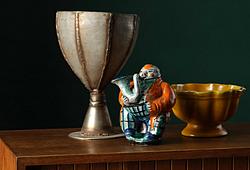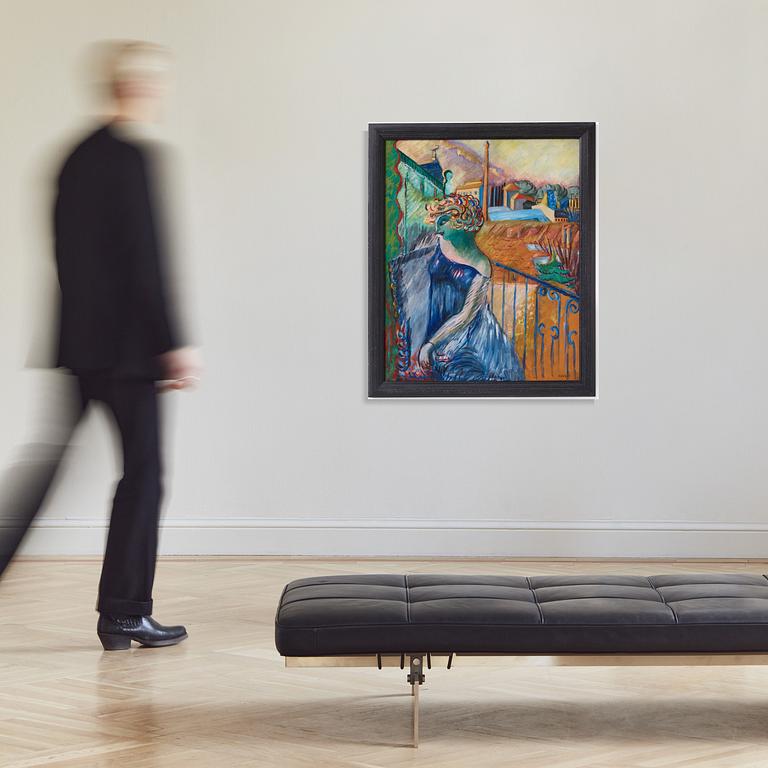Sigrid Hjertén
"Blondinen på terrassen"
Signed Hjertén. Executed in 1923. Canvas 100 x 81 cm.
Alkuperä - Provenienssi
Bukowski Auktioner AB, Stockholm, Vårens Moderna auktion 1996, cat. no 41.
Näyttelyt
Konstakademien, Stockholm, "Sigrid Hjertén oljemålningar och gouacher 1911-1936", April 1936, cat. no. 121.
Skånska konstmuseum, 1938.
Sundsvalls konstförening 1958.
Moderna museet, Stockholm, "Sigrid Hjertén 1885-1948", 1964, cat. no. 55.
Liljevalchs konsthall, "Sigrid Hjertén", Stockholm, 17 mars - 28 maj 1995.
Prins Eugens Waldemarsudde, Stockholm, "Sigrid Hjertén - En mästerlig kolorist", 10 February - 19 August, 2018, cat. no. 63.
Kirjallisuus
Carl Palme, "Sigrid Hjertén", 1936, listed p. 36 under year 1923, illustrated in black and white.
Elisabeth Haglund, "Sigrid Hjertén", 1985, illustrated in black and white and mentioned p. 24.
Liljevalchs exhibition catalogue, 1995, illustrated full page in color with no. 53.
Anders Wahlgren, "Sigrid Hjertén - En av Sveriges främsta konstnärer", illustrated and mentioner p. 130-131.
Görel Cavalli-Björkman, "Kvinna i avantgardet. Sigrid Hjertén. Liv och verk", 2017, illustrated p. 194.
Prins Eugens Waldemarsudde, Stockholm, "Sigrid Hjertén - En mästerlig kolorist", 10 February - 19 August, 2018, exhibition catalogue, illustrated full page p. 89.
Muut tiedot
When the Hjertén-Grünewald family returned to Paris in 1920 after nearly a decade in Sweden, they were accompanied by Isaac’s sister Bertha, who changed her name to Berthe upon arriving in France. They were in search of housing and a studio in Paris, but prices had gone up since their last stay in the city when they were students of Matisse. They ventured outside the bustling city blocks and settled in Fontenay-aux-Roses, southwest of Paris. It was a peaceful and blossoming suburb where the family resided in a house with a garden. Berthe helped with their son Iván, allowing Sigrid better opportunities to paint. Their stay in France in the 1920s marked a broadening of Sigrid’s art, She didn’t paint as much as before but developed an intimate color expressionism that was no longer under the influence of her old teacher Matisse, but rather under the influence of van Gogh.
In more or less anonymous depictions, the woman often constitutes a central theme during this period. The female figures can be interpreted as the various roles that Hjertén identified with-woman, avant-garde artist, wife, mother and intellectual. In her painting, she explores the expressions of these different personas. Over the years, she paints several portraits of women including “Brunetten och blondinen” (1912) Den röda rullgardinen” (1916), ”Dekorativt huvud (Det gröna ansiktet)” (1918), ”Berthe i röd hatt” (1921) and the painting in the auction ”Blondinen på terrassen” (1923). She is not alone in depicting the female body within avant-garde circles, but unlike many of her male colleagues, she takes a step away from portraying the female body in the conventional sense and instead seeks something else. This quest resulted in fantastic paintings with vibrant colors and skilfully executed brushstrokes.
Several of the early 1920s paintings have a truly masterful color composition. Sigrid paints with a newfound strength, a bold brushwork, quick and intense. Contracts create the atmosphere in “Blondinen på terrassen ” Foreground and background interchange, and the blonde’s head stands out with the same clarity as the city in the background. Sigrid builds the painting’s color scheme with a variety of values, contrasting cool colors with warm ones. Colors meet in intense contrasts, and the contours dissolve into the colors with warm ones. Like van Gogh, she made the subject quiver, vibrate and sway. The path to this resonant colorism went from Sigrid’s background in drawing, through her time as a student with Matisse in the 1910s, encounters with Cézanne and cubism, to her own intimate color expressionism. In Görel Cavalli-Björkman’s book, she writes that the subject was executed in the Paris studio, and the model in the picture is likely Bronia Perlmutter, who was also depicted by Isaac Grünewald and Nils Dardel.
In 1932, the Hjertén-Grünewald family moved back to Sweden, and Sigrid developed the mental illness that would come to affect the remaining years of her life. Today, we regard Sigrid Hjertén as one of the most beloved modernist of the 20th century. However, during her lifetime, she only managed to hold one solo exhibition at the Royal Academy of Fine Arts in 1936. By that time, she was already seriously ill and institutionalized in a mental hospital, and she did not get to fully experience the exhibition. Her fellow artist colleague Tor Bjurström wrote 1949 for Paletten, “ As she is, Sigrid Hjertén is one of the foremost female painters our country has ever had, and the first great one.”







































































